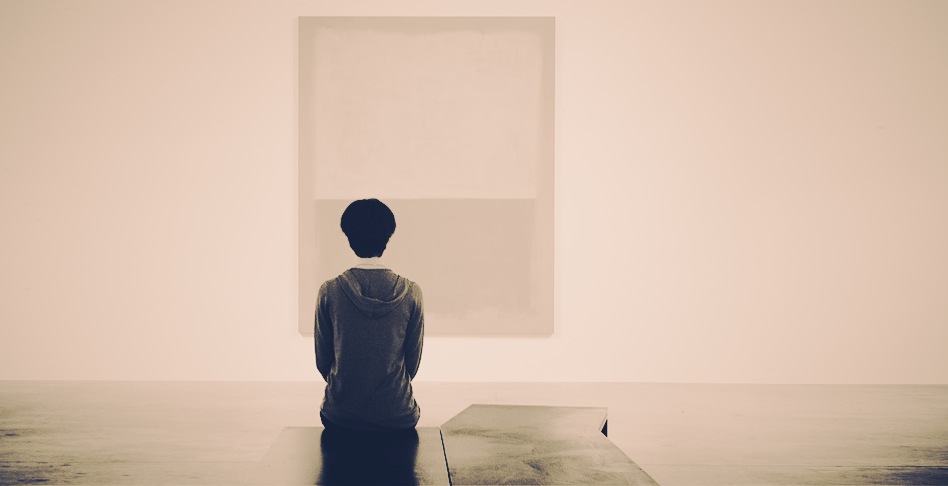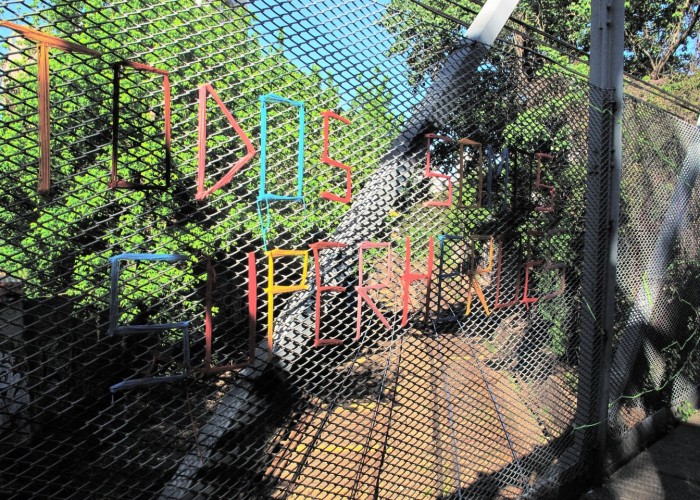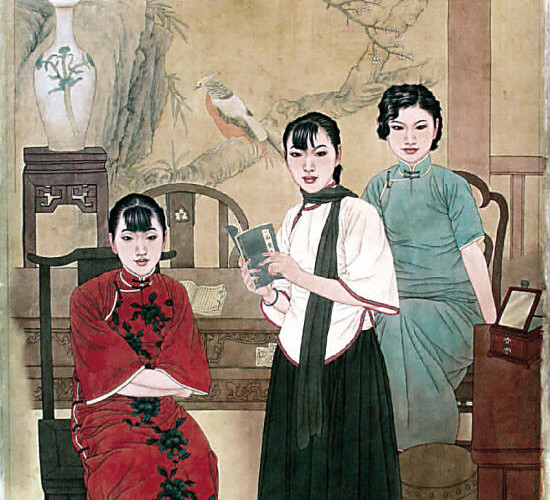The Red and the Black
María Gainza
translated by Jane Brodie
I’m scared. I’m sitting on a plastic chair waiting to see the doctor. It’s a cold spring morning and I’ve come here because my right eye has been twitching for several days. It throbs—intensely, insanely, especially the lower lid. I sometimes think it’s going to burst. I have ruled out the most obvious causes: it’s not fatigue because it sometimes starts up just five minutes after I wake up; it’s not strain because I haven’t read a thing for a week; it’s not alcohol or cigarettes or coffee because I’m a strict ascetic; I don’t believe in stress. I’ve considered possible illnesses. I went online and found forums for people with a twitch in their eye. One group even invited me to one of the meetings they have on Monday nights in the basement of the Hotel Bauen. They sit in a circle and recount a wide range of psychic woes: chronic melancholy, sick ideas, recurring headaches, feelings of unreality. Sometimes they invite a celebrity who has been afflicted with the “crazy eye” to talk about their experience, issues like how to keep the camera from capturing your inner quake. Sandra Ballesteros was supposed to go to the meeting I was invited to. I didn’t end up going, and I opened another e-mail account for fear of retaliation. Then, to put an end to the aftershocks, I made a doctor’s appointment.
The waiting room is white, immaculate. Across from me, a mother and son are also waiting to see the doctor. The boy, who is wearing thick glasses, is chewing gum, and when he looks at me he pulls it out of his mouth to form a hanging bridge that swings back and forth. His mother tells him to cut it out, but he keeps at it, and I look away. My eye starts twitching for the millionth time so far today. Then I see the Rothko. It’s a poster on the wall. I glance at it quickly because if I keep looking at it too long the beating in my eye starts to feel like a galloping horse. It’s a red vertical Rothko; I recognize it because I have seen it at the Museum of Fine Arts. A classic Rothko: a devil red on burgundy that veers into black.
People always say that until you’ve seen a Rothko in person you’ve only seen half of it. I’m surprised by how much there is to see in a reproduction, though. Even in a reproduction, Rothko seeps in through your body, not your eyes. Like a fire at stomach level. Some days I think that Rothko’s works are not works of art at all, but something else: the bush from the biblical story that blazes but never burns up. There is something in a Rothko that never grows old, despite its creator, despite the inflamed rhetoric that weighed down his works for so long. My generation was not co-opted by the hagiographers of the artist, writers steeped in Jung, Nietzsche and Heidegger, anything that might heighten the messianic dimension of Rothko’s work. For years, the myth made him out to be a creator of icons from the beyond, an idea that fascinated his collectors while also placing him firmly in the tradition of abstract art as spiritual trip, a tradition that began with Kandinksy. This is what I am thinking about when the secretary tells me that Dr. Despontin is ready to see me.
*
To the south of Saint Petersburg is the city of Daugavpils, formerly called Dvinsk. In the early 1900s, under the Czarist regime, there weren’t enough jobs to go around and young women saw prostitution as an employment opportunity. To avoid that fate, Anna Goldin married the pharmacist Rothkowitz when she was fifteen. She had four children. The youngest of them, Mark—the future Rothko—was the most sensitive. A hypocondriac, he was the only one who studied the Talmud. Though there is no historical record of killings in Dvinsk, as an adult Rothko described how “the Cossacks took the Jews from the villages to the woods and made them dig a large grave. I pictured that square grave so vividly that I´m no longer sure if the massacre actually happened or if I made it up, but that image has always tormented me.” One morning Mrs. Rothkowitz and her children got on a boat at the port of Libau. They headed to America to join the children’s father, who had left some months earlier. They landed in Portland, Oregon, and they still had sea legs when Mr. Rothkowitz died of colon cancer. The young Mark was just eleven years old. He was poor, a Jew and a leftist. He finished high school as best he could and received a scholarship to Yale to study law. Months later, when the crash of ‘29 was beginning to shake the country’s foundations, Rothko dropped out. He had decided to go to New York to “bum around and starve a bit.”
If he had actually starved at that point, Rothko would be a complete unknown today. Until the age of forty-five, he was just another painter. He went through a Surrealist phase, an intense mythological period that is strikingly unpromising with its mediocre employment of the line. Then, in the 1930s, he started painting wrenching urban architectures with elongated figures in the style of Giacometti. Everyone considered him a lost cause when the “eureka” moment happened, that moment artists wait their whole lives for and that sometimes arrives and sometimes doesn’t, the moment when the vision finally surfaces. It happened in the summer of 1945, when he set out to paint a series of blurry abstract blocks that floated in the space of the canvas. The line had disappeared, the colors had exploded: pinks, peaches, lavenders, whites, yellows, saffron with the evanescence of steam on glass. He had been studying Matisse and Milton Avery, and his entire eye seemed to have dilated. It was no longer just an optical organ; now Rothko could touch, smell and feel through it.
*
You stand in front of a canvas like a sunrise. You are bathed in its light. You are drunk on its color. It is not a harmonic or orchestrated color but a free color, a color that breathes within the painting. These are beautiful paintings, perhaps the most beautiful ever produced by an artist in North America. But beauty can be sublime or it can be decorative, and Rothko’s paintings went perfectly with the leather couches and angora rugs in the living rooms of New York’s Upper East Side. The critics tore him to pieces, and Rothko agonized while his bank account grew. Some accused him of manipulating effects and turning the rigor of Abstract Expressionism into a profitable business. He began to defend himself with statements like “Tragic experience is for me the only source of art.” It was like he was digging his own grave and for years that grandiloquence would drown his works, turning them into opaque menhirs instead of transparent windows.
The thing is, anxiety made Rothko talk too much. He forgot that the most powerful thing in a work is often its silences, and that style is a language in its own right, a means to insist on something. Looking at a Rothko is a spiritual experience of the sort that does not allow for words. It’s like visiting the glaciers or crossing a desert. The feebleness of language is rarely so patent. Before a Rothko, one looks for phrases from a Sunday sermon which are really just euphemisms for “holy shit.”
In the years of his greatest success, from 1949 to 1964, Rothko began to fall apart: his marriage ended; his friends left him; he was drinking like a fish, and he was embittered and contemptuous. He was caught in a downward spiral of destruction. One stormy night when he was leaving his building, the doorman warned him to “take care, the streets are rough.” Rothko answered, “There’s just one thing I have to watch out for: the black swallowing up the red.”
*
I have to keep my eyes shut until the drops take effect. I cheat, peeking through damp lashes every now and then. I look at the Rothko poster. I feel my pupils dilate. I open and close. When I open my eyes, the red sucks me in; when I close them, it floats on the black of my eyelids. I move closer, trying to follow Rothko’s instructions and stand forty-six centimeters away from the image. And I ask myself how this man could have made the euphorically abstract paintings of his best period during the lowest point of his fall? And that takes me to T.S. Eliot: “The more perfect the artist, the more completely separate in him will be the man who suffers and the mind that creates.” Dr. Despontin’s secretary orders me to sit down and I retrace my steps, eyes shut.
*
On the morning of February 25, 1970, Rothko walked into the bathroom, took off his shoes, placed his pants and shirt on a chair and used a razor blade to cut two deep slashes in his forearms. He had advanced emphysema. When his assistant found him, he was lying on his back in a puddle of blood, his arms stretched out to his sides. An hour later, when the police arrived, he was floating in a red pool the size of one of his paintings.
If style is character, now his detractors were faced with a work of sheer gravitas and a mystery to solve. A secret that Rothko had taken with him to the grave. What really happened in 1959 when, at the height of his career, Rothko refused to deliver the paintings he had made for the Four Seasons restaurant in the Seagram Building in New York, the highest paying commission in the history of Abstract Expressionism? Get off the subway at 375 Park Avenue, cross the street, look as far back as you possibly can, and you will see the building created by Mies van der Rohe in 1954. The Seagram is pure bronze, travertine stone and dark glass, a stylized tower colder than a logarithm. Now walk into the restaurant, as restrained as it is palatial. Do you see the palm trees, the small pool, the flambé dishes? Can you see the Mirós and the Frank Stellas behind the Picasso curtains? They cover the space where the Rothkos were supposed to be.
Why Rothko agreed to decorate a symbol of American economic power at the height of the Cold War is unfathomable. Dore Ashton, who visited him at his studio frequently, says that Rothko thought the murals were for the employees’ cafeteria. Others see this as farfetched and claim Rothko knew perfectly well that they were going to crown the luxurious restaurant. His friends Barnett Newman and Clifford Still turned out to be his worst enemies, calling him a prostitute of art. But, as someone I know would say, there are perfectly decent forms of prostitution. Rothko said something else, specifically to journalist John Fischer in 1959 on an ocean liner heading to Naples: “We must find a way of living and a work that does not mean the end of us all.” Between glasses of whiskey downed on the coach-class deck, Rothko told him that his master plan was “to ruin the appetite of every son of a bitch who ever eats in that room with paintings that will make those rich bastards feel that they are trapped.” He was thinking of Michelangelo’s oppressive Laurentian Library which he had seen in Florence some years before and was planning to visit again during this trip. Days later, in Pompeii, the Rothkos (his wife Mell, his daughter Kate, and now Fischer, who tagged along everywhere) visited the Villa of the Mysteries. Rothko was struck by the lusty use of red and black in the dining room dedicated to Dionysus, by the perverse way the colors blended together. All of this was in his head when he returned to New York and took his wife to lunch at the newly opened Four Seasons. His paintings were not yet on the walls; he said they needed some finishing touches. The restaurant was overflowing with navy blue Brooks Brothers suits, Stefano Ricci ties, pearl necklaces and ermine stoles. Rothko savored his gazpacho, his eyes nervously scanning the place. Suddenly, his spoon midway between his mouth and his plate, he asked Mell if she smelled something funny. “Like what?” she asked. “Like filthy money,” said Rothko. He then gulped down his cocktail, pushed the table back and announced that he would break the contract.
The murals that never made it to the Four Seasons are grey blocks on black backgrounds. When the scandal had died down and photos of the paintings came to light, everyone thought, “No wonder. These paintings are a dead-end street, a tragic fall.” Not at all. When the case is reopened, when the dark blotches on the wall are analyzed, we realize that Rothko was showing some muscle: he wanted to measure himself up against the corporations. He thought of his murals as a way of exposing the dirty laundry of the American empire. He wanted to rub their noses in their money and make a work as unwelcome as a piece of glass in the risotto. He wanted to resuscitate a central idea from his aesthetic creed, the notion of art as a vehicle for change. But in New York in the late fifties, all art could do was amuse. That day at the Four Seasons, Rothko understood that for the bankers and businessmen having lunch around him, his paintings, whatever color they were, would end up being as decorative as their wives.
*
Dr. Despontin assures me that I don’t have anything serious. It’s a twitch, an involuntary tremor of muscle fibers due to irritation. My eye stops throbbing. I’m going to live, he tells me. While I’m waiting for the elevator, I take a last look at the Rothko poster. I stare at it. It makes me feel unique: the ruthless loneliness of this sweaty piece of flesh that is me. It reminds me that I am alive and it saddens me, like when you cling to a promise of happiness that you know can’t be kept.
*
My husband got sick twice. Non-hodgkin lymphoma was the diagnosis. B cells the first time around, a long but relatively easy treatment; T cells the second, a devastating treatment that was twice as long. There are those who say, “You have no choice but to fight it when it happens to you. You would do the same.” I don’t think so. But he put up with it. In Ramos Mejía Hospital for a year. Nights like tunnels, a pleurisy that gripped his chest, lethal chemotherapy and countless other horrors that I will spare you. At the hospital there was a whore, a dark woman in a red dress and fishnet stockings. She would sleep during the day in the plastic chairs at the entrance, curled up against some bags that I guess held her belongings, shaking every so often as if a bolt of lightning had struck her inside. At night you could hear her walking through the wings of the hospital, her heels against the icy tiles; she went from one patient to the next, rubbing herself against the iron bars of the beds, doing what she had to do.
A Rothko was hanging next to my husband’s oxygen tube. It was a clipping from a magazine. He had other things up as well: a poster of his rock band, a postcard of sex symbol Coca Sarli in a river, a napkin autographed by Uruguayan soccer star “Prince” Francescoli. I was the one who had put up the Rothko; his friends had put up the other stuff in an attempt to cheer him up. He said that, like pictures of saints, the images helped him at night when the silence of the hospital was overwhelming. “Sometimes I take a dose of morphine and light them up with my flashlight. It helps a little.” One night when I stayed with him until late—it must have been eleven—the whore walked by and stopped by our bed. She greeted my husband by name and lingered to look at the images on the wall; the moonlight came in the window like a floodlight. “Was it just me or did she recognize the painting?” I asked my husband after she had left. “It’s not you; she’s seen it before. We were talking and now she says that ‘Roco’ is her favorite painter.” I ran into her again two nights later; we were waiting for the elevator but it had gotten stuck one floor up. While we waited, I smiled at her and tried my best to seem cool. I was curious about her interest in Rothko, the connection between art and the street in the most literal sense. But she avoided eye contact, putting me in my place as bourgeois arty girl, hospital tourist, armchair anthropologist fascinated by the exotic. I quickly understood and didn’t bother her further. When the elevator finally came, we went down in silence and walked out into the large central hall that connects the different wings to the lobby. She walked ahead of me. For a moment, I thought she was leading me to the chapel, to some sort of sacrifice or communion. But then she turned down a dark hall that led to the Hemodynamic Unit. Her dress was the last thing I saw, the precise instant that the red dissolved into the black.
* *
Image (modified) via artobserved.com
[ + bar ]
Book Market [lviv]
Natalka Sniadanko Translated from Ukrainian by Jennifer Croft
“No photos,” barks the geezer wearing the typically Soviet hat with the visor, synthetic leather sandals, an untucked shirt, and pants... Read More »
from The Sofa Sages
Eitán Futuro translated by Jennifer Croft
Lara began to kiss me. I hadn’t kissed her first because I thought you couldn’t kiss them on the mouth. I touched... Read More »
Love
Zhang Ailing translated by Qiaomei Tang
It is true.
There was a village. There was a girl from a well-to-do family. She was a beauty. Matchmakers came, but... Read More »
Hegira
Adam Morris
Slakers shambled along the coasts, the brine in the breeze searing nostrils, lashing cheekbones and the edges of eyelids, whittling parts of faces to... Read More »

![Book Market [lviv]](http://www.buenosairesreview.org/wp-content/uploads/tocada-700x500.jpg)






 sending...
sending...